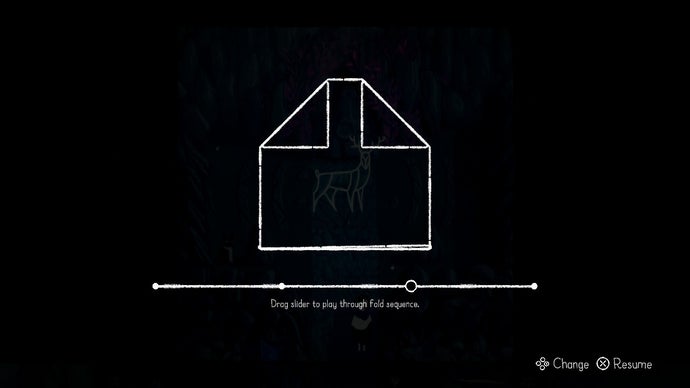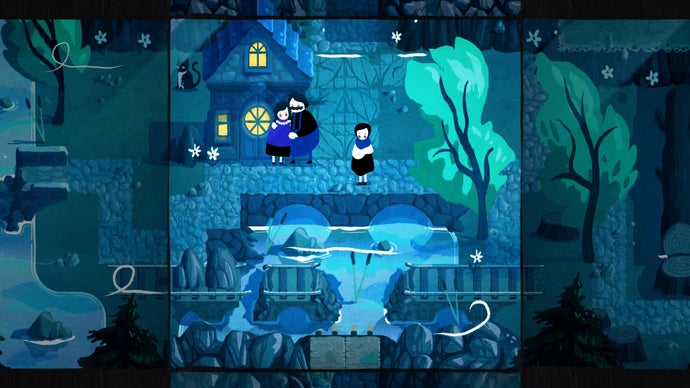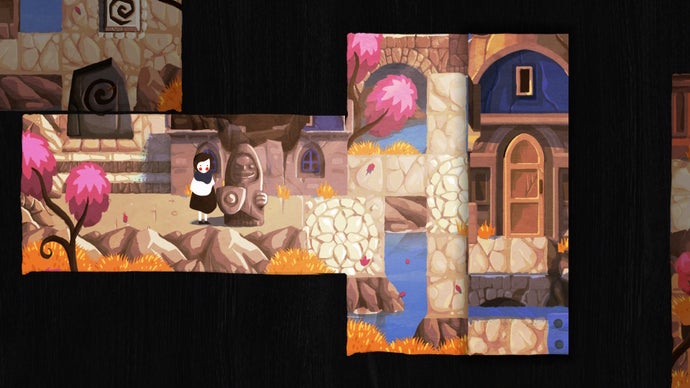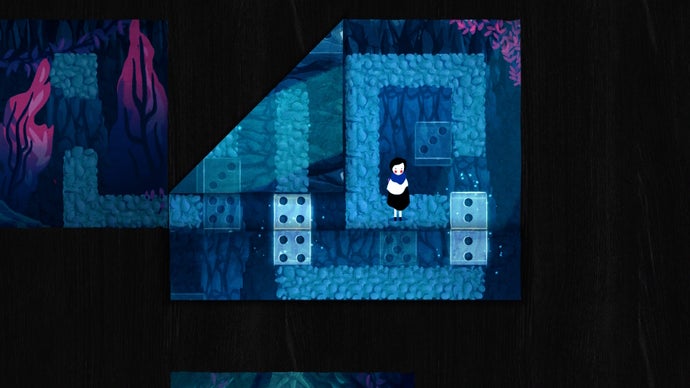It’s rather appropriate that the idea for Paper Trail – a game where you have to fold paper to solve puzzles – came from a brainstorming session where Newfangled Games’ founders and brothers, Henry and Fred Hoffman, folded the paper of their hand drawn levels, then noticed that the puzzles on the front and the back could combine to make an even bigger puzzle. This one magic idea stuck from the off – but Newfangled Games’ debut indie didn’t always look like the polished puzzler it is now. There were some conceptual design bumps in the road, a trip to Boxpark Shoreditch, and a Netflix deal to chase before they could reach Paper Trail’s true potential.
In the release version of Paper Trail, you play as Paige, who runs away from the ‘forgotten seaside town’ of Southfold to pursue her dream of attending university and becoming an Astrophysicist. Instead of just catching the train like the rest of us, Paige bends the space-time continuum to fold the world around her. You see her rural world from a top-down perspective, like looking at a piece of paper, and then you fold the world, just like that paper, to reveal the pattern on the other side to create paths, move objects, and combine symbols. A simple mechanic that creates some deceptively hard, but rewarding, puzzles. However, initially, Paper Trail was more of a sidescroller, but “there wasn’t a huge amount of variety you could do with it,” Henry Hoffman tells me as I chat with him on a video call. “It was interesting one-off interactions, but it didn’t really have any scope beyond that.”
So then Paper Trail transformed into more of a Metroidvania, where you fold the map itself rather than the levels. “And it’s funny,” Henry tells me, “because we weren’t aware of Carto at the time, and I don’t think Carto had come out, but that’s very much what that ended up doing, where you’re zooming out and manipulating the environment and rearranging.” But this map folding didn’t work for them either, “because there wasn’t any real immediate feedback from folding the macro environment,” Henry explains. “You would do that and then you wouldn’t really see exactly what had happened, it would be a little bit confusing and disorienting.”
Everything started to come together when the team tried a top-down perspective. “Suddenly, that became much more interesting,” Henry says, “because [you can] have this walkable path on the front and on the back, and you can fold the corner and it rotates, but it still looks like it’s walkable. So you create these Escheresque moments where you can create walkable and unwalkable paths.”
Another big change was actually the game’s size. “[Paper Trail] was really only going to be probably a quarter of the scope that we ended up doing,” Henry explains, but the team wanted to explore the full potential of their top-down paper folding mechanic. Like, what would happen if some of the levels were L-shaped, instead of square? “We didn’t want to stop until we had kind of maximised the mechanics potential, essentially.”
That’s where funding from third parties like Astra Logical and Netflix helped the Hoffman brothers increase Paper Trail’s scope. Once the Netflix deal was made, Henry said that they could “do [Paper Trail’s] core mechanic justice,” and “make the dream game that we wanted to make.” Curious about how working with Netflix came about, I asked Henry if Netflix approached Newfangled Games initially. “I wouldn’t say that they approached us,” Henry laughs. “It’s more like we approached them repeatedly, and they said no again and again, and then they eventually said yes.” He’s cautious to reveal specifics of the deal due to NDA restrictions, but reiterates that “without [Netflix’s] support, we wouldn’t have been able to realise the full game that we did in the end.”
That support came financially, yes, but Netflix also played a part in shaping how Paper Trail plays. Like one of their QA testers catching a flaw late on in development that allowed players to unfold one of the hardest levels in the game just once, skipping its puzzle entirely. Additional help came with allocating more resources to the hint system, which Henry tells me was something planned from the beginning, but that they just couldn’t get right. Initially, it was white footprints that guided the player, but that looked visually noisy, then an x-ray mode that showed the solution through the paper, but “we never were able to do it in a way that felt intuitive and natural,” Henry explains.

Now, the final hint system is one of my personal favourites, as it’s just visual instructions on the order that you have to fold a level in, with a slider that lets you go through the various folds as often as you like. It doesn’t tell you exactly how to complete a level, but is informative enough to help with tough puzzles (which Paper Trail has plenty of). And rather appropriately, Henry came up with the final hint idea one night late in development by looking at step-by-step origami instructions. I asked Henry if physical origami-inspired solutions like this carried on into the level development of Paper Trail. Did he continue to design the puzzles on paper first?
“I would love to say that there was a real analog approach to the puzzle design,” he says, “But the reality is, it’s super hard folding a piece of paper multiple times, and there’s multiple solutions to a puzzle and lots of different variations and lots of different stages to a puzzle. And in fact, not only could I not do it on paper, but I couldn’t do it digitally unless we built this tool, which allowed us to fold the levels and design the puzzles simultaneously. That was a big help. Basically, we wouldn’t have been able to do nearly as much puzzle design without that.”
With such a complicated way of designing levels, I was curious if there were any other hurdles that limited what the team could do with Paper Trail’s paper-folding design. Henry ponders on this for a moment, then relays something the game’s programmer told him in a conversation they had after launch: “I kept saying that this technical thing was impossible, then you kept saying ‘Do it anyway,’ and then I did it anyway.”
So the biggest personal challenge for Henry personally actually came from spinning all the plates that came from self publishing Newfangled Games’ first game. “I was kind of managing that whole publishing process end-to-end, but I was also designing all the levels, and doing character art, and doing all the sound design, and like a ton of other stuff you do as an indie… I think I probably underestimated how much work self publishing is. Like, having to [simultaneously ship] on so many platforms, going through the back ends for Xbox, and Nintendo Switch and PlayStation, managing all the regions, making sure that everything is compliant – all the age ratings and everything else.”
“There’s a reason publishers exist, I guess,” he laughs.

One of Henry’s many jobs was designing Paper Trail’s characters, and although the beautifully illustrated backgrounds drawn by his brother, Fred, are purposefully reminiscent of Japanese watercolour paintings, the characters are actually inspired by Romanian tattoo illustrations that Henry and Fred spotted while at Boxpark Shoreditch. The red rosy cheeks contrasted with the pale character designs stood out to them, and they found that the Eastern European look worked well from a flat front-on perspective, when paired with their top-down Japanese-inspired backgrounds.
Although Paper Trail is primarily a series of puzzles you work through, there are some character interactions with the locals, who speak in an adorable Simlish-like manner. Originally, a Night In The Woods sound-effects-for-voices style was considered, but Henry tells me that felt too digital. “That was the biggest problem I had with a lot of the sound design,” he says. “Other games that did it had a very digital treatment to them, which worked, but because ours felt so analog with the paper folding and that analog aesthetic… we felt like we had to have these character sounds that did that as well.”
So the team got an audio designer specifically for the character sounds and hired voiceover artists to do ‘Simlish’ of varying lengths. Based on how much text there is in the game, a random sound snippet then plays based on the text length. “Surprisingly it was a bit controversial,” Henry says, “Some people said they really liked it, some people found it annoying. So we provided the option to mute the characters if you wanted to.”
I find myself on the ‘really liked it’ side, as even though the jumbled voices are a very small detail, it helps add a lot of charm to Paige’s journey, when combined with the soft vocalised soundtrack and gorgeous artwork.


Simlish controversies aside, I ask Henry what’s next for Newfangled Games. Is there potential for Paper Trail DLC, or has work fully shifted to the next game now? “We are still looking at potential DLC stuff… At the moment, we’re just trying to figure out how we divide the team. Do we focus fully on the next project? Do we divide the team and continue doing DLC? Because we’re a tiny team, so we’re still trying to figure it out at the moment.”
Work has started on a new 3D game, but Henry understandably doesn’t want to reveal too much about it at this early stage of development. “New, innovative games or game mechanics lend themselves really well to puzzle games, but I don’t think that’s exclusively what we have to do,” Henry tells me when I ask whether the new game will be a puzzler. “One of the things I’m really interested in at the moment is exploring unique mechanics and how that can be applied to other genres and how we can broaden an audience and bring more people into games with innovative mechanics. So that’s kind of what we’re exploring at the moment.”
Even with just these small hints, I can’t help but get excited for what’s next for Newfangled Games, regardless of genre. Paper Trail is proof enough that its developers can make magic with just one simple idea.
